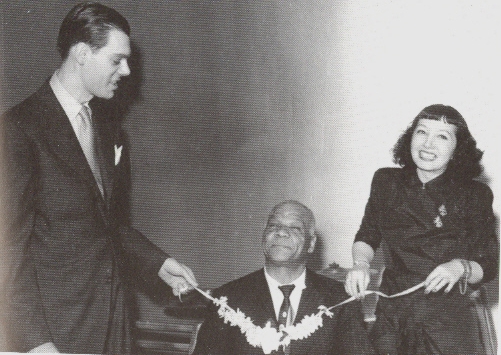
Revision note: Some of copies of Jazz Ltd. 821J-2939 (the last single on the label, released in 1968) were sold in a jacket. Photos of the jacket, at discogs.com, finally enable us to identify the personnel for the single, which added two trumpet players, a trombonist, and a clarinetist to the working ensemble at the club. Atlantic once had plans (they were announced in April 1955) to reissue Jazz Ltd. JL 1003 as a 10-inch LP. Instead, Atlantic waited several years before putting 4 tracks from JL 1003 onto a 12-inch LP. We can now document Jazz Ltd.'s licensing deal with Regal, which was announced during the NAMM convention in Chicago in July 1950 (the matrix numbers for the LP sides are from June). The resulting 10-inch LP on Regal was one of just two released by that compnay. The deal came to an abrupt end when Regal shut down in November 1951.
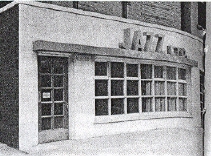
Jazz Ltd. was a boutique operation run by Bill and Ruth Reinhardt. It grew out of their club, Jazz Ltd., at 11 East Grand Street. The club opened on June 11, 1947 and successfully specialized in Dixieland. Initially Doc Evans' Dixieland Jazz Band served as the house ensemble; cornetist Paul "Doc" Evans had built a reputation in Minneapolis for some years before coming down to Chicago to play at the new club. Other members were pianist Don Ewell, trombonist Munn Ware, drummer Danny Alvin, plus Bill Reinhardt himself on clarinet. Down Beat's Paul Eduard Miller gave the club's gala opening a feature write-up, lauding the work of the band and praising the club's warm contemporary décor that managed handsomely without the "usual chromium and mirrors." The Reinhardts had hired Hugo Weber and Emerson Woelffer of the Institute of Design to create the décor for the intimate room; the club seated just 83 at the tables and another eight at the bar. Because of the limited size of the room (hence the name of the club), the Reinhardts found it unnecessary to use mikes or a speaker system.
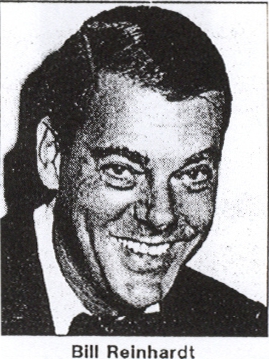
Bill Reinhardt was born September 21, 1908, in Chicago and raised in the city. After one year attending the University of Illinois, he headed to New York to work as a musician. There he met a Broadway show dancer, Ruth Sato, born of an Irish mother and a Japanese businessman in New York on December 12, 1904. They got married in 1941, a few months before Reinhardt entered the U.S. Navy during World War II. After the war, the couple settled in Chicago. Responding to the explosion of interest in Dixieland music, they decided to open a club that would specialize in it, while providing a venue for Bill Reinhardt to play his clarinet regularly. The club featured no singing, thereby avoiding an additional 20 percent tax.
Ruth Reinhardt served as the club's hostess. She and Bill set down some rigid rules for the club's operation: no unescorted ladies, no women served at the bar, no minors, no jacketless men—and only male servers. Many of these rules were animated by the Reinhardts' desire to keep prostitution (and by extension the Mob) out of the club. The Reinhardts were highly concerned about mobsters, refusing to buy liquor from Mob-connected distributors. During shows, loud patrons were immediately escorted out of the premises by the no-nonsense Ruth, who confessed she had developed a reputation for being a "schoolmarm." The club served the "best of liquor" and boasted of air conditioning that cut down on the smoke and foul air; Ruth summed up the club's virtues as "we are the antithesis of a barrelhouse joint for jazz." The result was that in the club's first years the room was filled every night and reservations for tables were the rule—according to Ruth this was a procedure heretofore unknown in Chicago. The club was open to African-American patrons, but few attended as Dixieland had little following in the black community.

Probably the Reinhardts' biggest coup was landing jazz pioneer Sidney Bechet for four extended engagements. Bechet was in residence at the club from November 1947 through June 6, 1948; for a five-week engagement from August 25 to early October 1948; for nearly two months from November 1948 through January 15, 1949; and finally for a four week-engagement in September-October 1949.
At some point the Reinhardts decided to go into the studio to record some of the headliners at their club with the house ensemble plus a bassist. They also sought to capitalize on their patrons' demand for Sidney Bechet's "Egyptian Fantasy," which fans enjoyed at the club, and was being featured by a local DJ during Bechet's first engagement there, but was out of print in its 1941 Victor version. Their other releases featured two regular members of the Jazz Ltd. house band, Don Ewell and Doc Evans, and New York-based Muggsy Spanier, who returned to his native city to play at Jazz Ltd. for a long engagement from January through July 1949.
Sidney Bechet, who played clarinet and soprano sax, was born in New Orleans, on May 14, 1897. He was one of the pioneers of jazz, beginning his career playing the clarinet with such legendary artists as Buddy Petit, John Robichaux, and Bunk Johnson. He toured the southern states with Clarence Williams from 1914 to 1916. Bechet worked with King Oliver in New Orleans in 1916, before moving to Chicago in 1917 to work with a variety of bands, notably that of Freddie Keppard (at the Deluxe) and Tony Jackson (at the Pekin Theater). He went overseas for the first time in 1919, winning praise for one of his solo features in a pioneering jazz review by the classical conductor Ernest Ansermet. He also discovered a soprano saxophone in a music store in London.
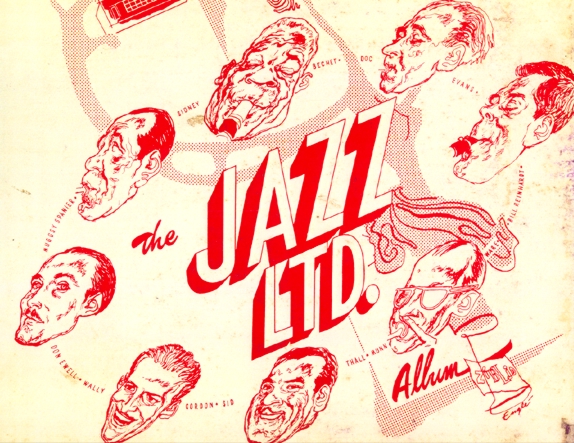
Returning to New York, Bechet made his first recordings with Clarence Williams' Blue Five in 1923. Beginning in October 1924 the ensemble also included Louis Armstrong; during this period Bechet also played in an early Duke Ellington Orchestra. From 1925 to 1931 he worked in Europe. He began an affiliation with Noble Sissle in 1928; this continued off and on through 1938. In 1932, Bechet cut his first American recording session in seven years; at the time so little work was available that he was operating a tailor shop in Harlem. Business began to pick up in the late 1930s; he recorded for Decca and Columbia in 1938, for the fledgling Blue Note label in 1938 and 1939, and for RCA Victor from 1939 through 1941. In the early 1940s, Bechet led a trio playing at the famed Nick's in New York City, and appeared a number of notable concerts with Eddie Condon at the Town Hall. During World War II and the immediate postwar years, Bechet largely worked in clubs on the East Coast; he recorded for Blue Note again in 1944 and 1945. In 1945, he performed in New Orleans and Boston (notably at the Savoy Café with Bunk Johnson). From 1945 through 1947 he recorded with Mezz Mezzrow for his King Jazz label; in 1947 he also recorded for Columbia. By the time he began appearing at Jazz Ltd. Bechet had hung up his clarinet and was playing soprano sax exclusively, probably because the small saxophone required less lung power.
The Reinhardts had intended to open Jazz Ltd. in May 1947 by bringing in the now legendary Bechet from New York for a long-term stay. (Knowing Bechet's tendency to grab the lead, which had led to friction with Louis Armstrong and Bunk Johnson in recent years, they simply booked him in place of a trumpet player.) Although he had been in town for a couple of one-nighters, Bechet hadn't held a club gig in Chicago since 1919, and the Reinhardts knew that his growing acclaim as a result of the Dixieland revival made him a top-notch attraction for the club. However, illness prevented Bechet from making the engagement as planned, so the couple delayed the opening a few weeks into early June and opened with the Doc Evans band.
Bechet sources: George Hoefer, "Sid Bechet Has Led Long, Colorful Life as Jazzman," Down Beat, 14 December, 1951, pp. 2, 6-7, 18; Ruth Sato Reinhardt, "Jazz Ltd. Owner Tells Tavern's Tale," Down Beat, 21 April 1948, p. 17; John Chilton, Sidney Bechet: The Wizard of Jazz (New York: Oxford University Press, 1987). Chilton devotes a full chapter to Bechet's Jazz Ltd. engagements, "Chicago Showdown," pp. 201-211. Tom Lord, The Jazz Discography, Volume 6 (Redwood NY: Cadence Jazz Books, 1993): pp. E432-E438.
Cornetist Paul Wesley "Doc" Evans was born in Spring Valley, Minnesota, on June 20, 1907. He developed facility with cornet, violin, piano, drums, and saxophone, but it was his cornet playing that the Carlton College band wanted. Upon graduation from Carlton in 1929, he taught school and then raised cocker spaniels, making music a part-time endeavor. In 1939, Evans became a full-time musician when he joined the Red Dougherty band. During much of the 1940s he led his own band, also playing with Bunk Johnson, Eddie Condon, and other traditional jazz musicians. In what one would think was a distant outpost for jazz, Minneapolis, Evans developed a national reputation, which led to him being called down by the Reinhardts to open their club. He had already recorded two albums in New York City, for Moses Asch's Disc label in April 1947, and would cut 8 sides in Chicago in December 1947, not long after completing his first engagement at Jazz Ltd. However, his recording session was done by John Steiner and initially released on Dublin's, a label operated by a local jazz record store.
Evans sources: "Doc's 'Formula' Puts Emphasis On Ensemble Value, Subordination," Down Beat, 1 December 1948, p. 4; Leonard Feather, Encyclopedia of Jazz (New York: Horizon Press, 1955): 136; Tom Lord, The Jazz Discography, Volume 6 (Redwood, NY: Cadence Jazz Books, 1993): pp. E409-E413.
Pianist Donald Tyson Ewell was born in Baltimore, Maryland, November 14, 1916. He formally studied music at the Peabody Conservatory, and during 1936-40 performed with a local Baltimore swing band, called The Townsmen. During World War II he played with military bands. After the war, with the burgeoning Dixieland movement, Ewell learned to play in the traditional manner and found a career playing Dixie in a host of bands, first with Bunk Johnson in 1946, followed by that of Doc Evans at Jazz Ltd.
Ewell sources: Leonard Feather, Encyclopedia of Jazz (New York: Horizon Press, 1955): 136; Tom Lord, The Jazz Discography, Volume 6 (Redwood NY.: Cadence Jazz Books, 1993): pp. E432-E438.
Cornetist Muggsy Spanier was born Francis Joseph Spanier in Chicago on November 9, 1901 (the 1906 date that used to appear in many sources is incorrect; our thanks to Bert Whyatt for a correction). He spent some years in an orphanage after his parents separated. While still in high school he was already playing in local cabarets. Noted for his strong lead and his exquisite use of the mute, he played with a host of different musicians during the 1920s, notably George Wettling and Jess Stacy, and made a number of Chicago style jazz recordings, starting with the Bucktown Five for Gennett in 1924. From 1929 to 1936 he toured with the Ted Lewis Band, followed by a stay with the Ben Pollack Band from 1936 to 1938. He suffered a physical collapse which left him near death at the Touro Infirmary in New Orleans, a period of his career later celebrated on two records he made.
Spanier returned to music in 1939, when he made 16 legendary sides for the Victor subsidiary Bluebird. After brief stints with Ted Lewis and then Bob Crosby, he formed the first of his own bands in New York City in 1941. Recording for Decca, the band cut some of the best traditional jazz recordings, soon to be celebrated as "Dixieland." Spanier continued to work largely out of New York (particularly at Nick's) from 1944 to 1948. He began touring in 1949 with a band that included Darnell Howard, Floyd Bean, Ralph Hutchinson, and Truck Parham. From mid-January through July 1949, Jazz Ltd. had Muggsy Spanier headlining a band that consisted of Joe Sullivan on piano, Reinhardt on clarinet, Munn Ware on trombone, and Wally Gordon on drums. Down Beat commented at the time that the band was "playing the best Dixieland in town."
Spanier sources: George Hoefer, "Muggsy Still a Driving, Communicative Jazzman," Down Beat, 4 May 1951, pp. 2-3, 8, 16; "Spanier, Sullivan Working Together Again at Jazz Ltd.," Down Beat, 20 May 1949, p. 4.
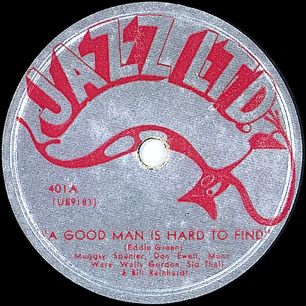
The usual story (told in Lord's Jazz Discography, and in the notes to the currently available CD reissue, Delmark DE-226) is that all of the early Jazz Limited material, totalling 8 masters, was cut in late February 1949. However, Pat Harris, in her "Chicago Band Briefs" Down Beat column from January 28, 1949, tells a different story. Announcing the upcoming Jazz Limited album, she noted that "at press time" (that would mean at least a week before Down Beat's publication) Bechet had already cut three sides and Don Ewell had recorded one. Still to be recorded were two sides by Doc Evans and two by Muggsy Spanier. In a news item from March 11, 1949, Down Beat subsequently reported on the recording of the Evans and Spanier sides: "Final sides cut for the Jazz Ltd. album, to be issued by and through the nitery here...Previously recorded were a Don Ewell piano solo on Maple Leaf Rag and three Sidney Bechet sides..." The second Down Beat item, on the other hand, does claim that the same rhythm section is on all of the tracks. No doubt this is what Jazz Ltd. told the writer, for the same information is on the original 78s—but as we will explain below, we doubt this. Doing a little fence sitting, Chilton says that the Bechet sides were recorded in "early 1949," fully aware that the musician left for New York right after his engagement ended—on January 15. We also have our doubts about an early January date.
Notes on the first Jazz Ltd. recordings: Tom Lord, The Jazz Discography, Volume 2 (Redwood NY: Cadence Jazz Books, 1992): p. B328; Pat Harris, "Chicago Band Briefs: Boppers Get Two More Breaks; Burkhart Back," Down Beat, 28 January 1949, p. 4; "Muggsy, Doc Cut Final Ltd. Sides," Down Beat, 11 March 1949, p. ?:
Well out of line with the February 1949 recording date (or even an early January date for the Bechet sides) are the matrix numbers on the 78s. These come from United Broadcasting Studios (which Sidney Bechet also used for his and Mezz Mezzrow's final sessions for the King Jazz label, December 18-20, 1947). We know a good deal about the studio's matrix series because the Miracle label had been recording there since 1946, and other Chicago-based indies (such as Sunbeam, Hy-Tone, Vitacoustic, and Aristocrat) made at least occasional use of UB's facilities. The Jazz Ltd. sessions were assigned two blocks of matrix numbers in the UB9100s: UB9101-9104 for Bechet and Ewell; UB 9181 through 9184 for Evans and Spanier. The UB9000 series really began in the summer of 1948, when Chicago studios resumed recording after the Musicians Union imposed a recording ban on January 1 of that year. The ban was not officially lifted until December 13, 1948. Even though everyone but the majors was busily recording before that date, companies worried about retribution from the union gave out phony dates for sessions cut in the summer or fall. The UB9000 series may have been organized to give the impression that it covered only sessions conducted in 1949, but blocks of matrix numbers up to the UB9500s are known to derive from sessions done before the end of 1948.
In fact, a UB9100 series matrix number would normally indicate a recording made in the summer of 1948. A current matrix number for a February 1949 session at United Broadcasting would have been in the UB9600s.
There is hard evidence for the Evans and Spanier session taking place in February 1949; it could not have taken place before the third week of January, when Muggsy arrived from New York to begin his engagement at the club, and the earlier Down Beat article signals that his session had not yet taken place. (Muggsy was in town in October 1948, playing the Blue Note, but he used a completely different band on that occasion.) We'll assume that United Broadcasting had an unused block of matrix numbers (maybe even had held onto one after Jazz Ltd. announced recording plans earlier) and this got applied to the Evans/Spanier session despite the late date.
Meanwhile, the same Down Beat article states that the three Bechets and the Ewell had been cut already (as in fact the Bechets had to be—he'd left town on January 15 and wouldn't be back till fall). Given the lack of a precise recording date in contemporary coverage, all we can infer is that the first Jazz Ltd. session took place during one of Sidney's previous gigs at the club. Since Don Ewell gets the trio feature on the session and the band pianist on the Bechets sounds like him, too, this means either Sidney's second engagement (August 25 to early October 1948) or his third (November 1948 to January 1949). The UB9100 matrix numbers still push for the earliest possible date, so we will go with late August 1948.
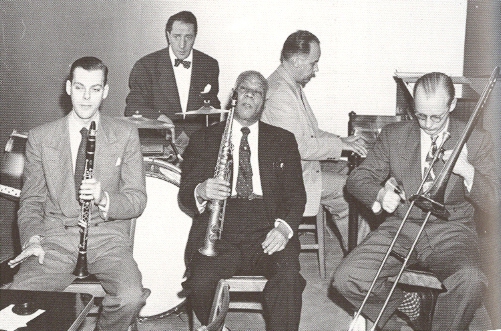
Further evidence in support of an early date is George Hoefer's "Hot Box" column from June 16, 1948. Headlined "Few Discerys Cash In On Bechet's Popularity," Hoefer's column declares, "There hasn't been a jazz artist appearing in the Windy City who has stimulated sales of his own recordings as Sidney Bechet has during the past few months... RCA Victor certainly missed a good bet by not reissuing the New Orleans Footwarmers, Bechet-Ladnier Bluebirds, and the Sidney Bechet Victors."
In fact, they have been missing the boat in Chicago for a couple of years by not making availiable [sic] the Bechet recording of Egyptian Fantasy. This record has been used on numerous local radio shows as the theme song for the very popular disc jockey, Linn Burton. The original record is so rare that is almost impossible to even find a copy from which to dub an acetate. (Down Beat, June 16, 1948, p. 12)
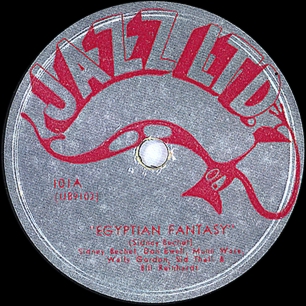
So here was Hoefer talking up the demand for "Egyptian Fantasy" just as Sidney's first engagement at the club was drawing to a close (the engagement ended June 6, 1948). The Jazz Ltd. management hadn't responded yet; the article came out after Sidney left, and while mentioning some 1947 recordings by Sidney that were due to be released it breathes no hint of recording efforts by Jazz Ltd. or any other Chicago indy. But plans could easily have been made to record Sidney as soon as he got back to town. Indeed, six weeks later Ted Hallock's column, "Chicago Band Briefs," was already announcing Sidney's planned return (Down Beat, July 28, 1948, p. 4).
Accepting two sessions a few months apart makes a lot of sense but gives us one new problem. Jazz Ltd.'s labels and the front cover of its album name the same supporting cast for both sessions. Munn Ware, Bill Reinhardt, and Don Ewell were working at the club across this entire period. It's reasonable assume that Sid Thall, the bassist, who sat in at the club on a few occasions and was hired to fill out the sound in the studio, could make two different sessions. But the drummer gives us trouble. The Jazz Ltd. album credits Wally Gordon with all the drumming, yet we have no evidence that he ever worked the club until mid-January 1949, when he came on board for Muggsy Spanier's arrival. The drummer on Sidney Bechet's third engagement was Johnny Vine; on the second the club used Doc Cenardo (who stayed after Doc Evans finished headlining at the club in August, but left for a while after the second Bechet engagement to work with Evans on other gigs, and was a regular member of Evans' band in 1949). We'll go with Cenardo, who returned to Jazz Ltd. and later appeared on label's 1951 session.
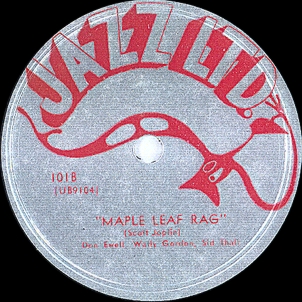
Sidney Bechet (ss); Munn Ware (tb); Bill Reinhardt (cl); Don Ewell (p); Sid Thall (b); prob. Enos "Doc" Cenardo (d).
United Broadcasting Studio, Chicago, prob. late August 1948
| UB9101-JL | Maryland, My Maryland | Jazz Ltd. 201A (album issue), Jazz Ltd. 201A (reissue), Regal LP 11, Jazz Ltd. JL1002 [?], Atlantic ALS-140, Atlantic 45-526-A, Atlantic LP1261, Delmark DE-226 [CD] | |
| UB9102 JL | Careless Love | Jazz Ltd. 201B (album issue), Jazz Ltd. 201B (reissue), Regal LP 11, Jazz Ltd. JL1002 [?], Atlantic ALS-140, Atlantic LP1261, Jazz Ltd. EP 101), Delmark DE-226 [CD] | |
| UB9103 JL | Egyptian Fantasy (Bechet) | Jazz Ltd. 101A (album issue), Jazz Ltd. 101A (reissue), Regal LP 11, Jazz Ltd. JL1002 [?], Atlantic ALS-140, Atlantic LP1261, Jazz Ltd. EP 101, Delmark DE-226 [CD] | |
| UB9104 JL | Maple Leaf Rag (Joplin)* | Jazz Ltd. 101B (album issue), Jazz Ltd. 101B (reissue), Regal LP 11, Jazz Ltd. JL1002 [?], Atlantic ALS-140, Atlantic LP1261, Herwin 401, Blue Star [Fr] BLP6838, Delmark DE-226 [CD] |
The original 4-pocket album release on the red on silver Jazz Limited label took place in March 1949. In June 1949, Jazz Ltd. 101 and 201 were reissued as singles on a maroon on gray Jazz Ltd. label, distributed by Old Swing-Master.
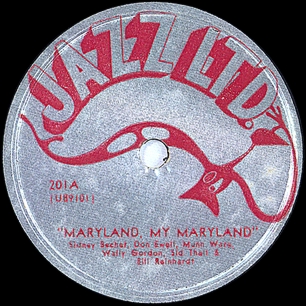
Lord's Jazz Discography fails to mention the album, or the reissues distributed by Old Swing-Master. And Lord puts "Egyptian Fantasy" on a non-existent 202, stranding "Maple Leaf Rag" on 101 without a flip side!
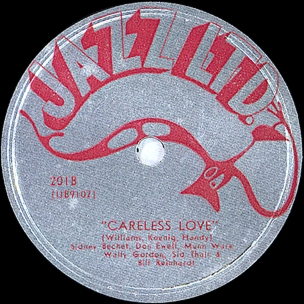
Regal LP 11 was a 10-inch LP released in 1950 under the title The Jazz Ltd. Album; it used a modified version of the the original Jazz Ltd. cover art. The tracks were not put in order by artist or session on the LP masters, which were RL 1319 for Side A and RL 1320 for Side B (although the Jazz Ltd.-Regal deal was announced in July 1950, the matrix numbers appear to date from June). Atlantic ALS-140, Dixieland at Jazz Ltd.—Vol. 2, was issued in 1952, after Regal went out of business. Atlantic LP1261, released in 1957, was titled Dixieland at Jazz Ltd. Atlantic 45-526 was released sometime in the mid-1950s. On the labels (and on the sleeve that some copies were packaged in) it was titled Dixieland at Jazz Ltd. with Doc Evans. "Wolverine Blues" was meant to be the second track on Side A, and is listed on the label, but "Maryland, My Maryland" ended up being mistakenly subsituted for it. The Jazz Ltd. EP, numbered 100 on Side A and 101 on Side B, was a commemorative reissue of Sidney Bechet and Muggsy Spanier sides that came out in 1967; two Bechet numbers were selected for the B side. Herwin 401 was an LP compilation from the 1970s, titled They All Played the Maple Leaf Rag.


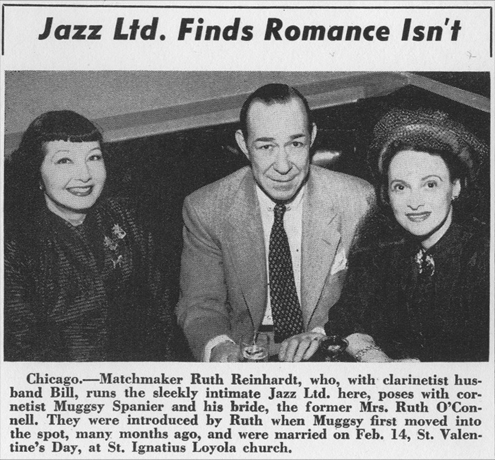
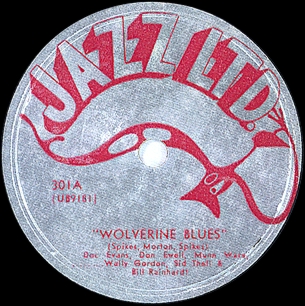
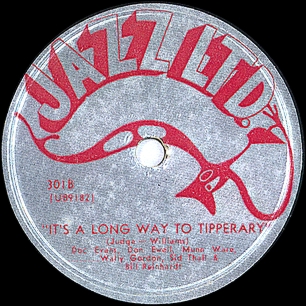
Doc Evans (cnt) or Muggsy Spanier (cnt on *); Munn Ware (tb); Bill Reinhardt (cl); Don Ewell (p); Sid Thall (b); Wally Gordon (d).
United Broadcasting Studio, Chicago, February 1949
| UB9181 JL | Wolverine Blues (Spikes-Morton-Spikes) | Jazz Ltd. 301A (album issue), Regal LP 11, Jazz Ltd. JL1002 [?], Atlantic ALS-140, Atlantic LP1261, Delmark DE-226 [CD] | |
| UB9182 JL | It's a Long Way to Tipperary (Judge-Williams) | Jazz Ltd. 301B (album issue), Regal LP 11, Jazz Ltd. JL1002 [?], Atlantic ALS-140, Atlantic 45-526-A, Atlantic LP1261, Delmark DE-226 [CD] | |
| UB9183 JL | A Good Man Is Hard to Find (Green)* | Jazz Ltd. 401A (album issue), Jazz Ltd. 401A (reissue), Regal LP 11, Jazz Ltd. JL1002 [?], Atlantic ALS-140, Atlantic LP1261, Jazz Ltd. EP 100, Delmark DE-226 [CD] | |
| UB9184 JL | Washington and Lee Swing (Allen-Robbins)* | Jazz Ltd. 401B (album issue), Jazz Ltd. 401B (reissue), Regal LP 11, Jazz Ltd. JL1002 [?], Atlantic ALS-140, Atlantic LP1261, Jazz Ltd. EP 100, Delmark DE-226 [CD] |
The original Jazz Ltd. issue numbers are correctly reported in George Hoefer's detailed review of the album, in Down Beat for June 3, 1949. Lord's Jazz Discography makes no mention of the original album—or of the fact that 101, 201, and 401 reappeared as separate 78s under the Old Swing-Master deal, while 301 did not.
In late 1948 Doc Evans began an extensive engagement on Chicago's North Side at the Tailspin Lounge, where the Down Beat writer noted that it was the first band he'd led since leaving Minnesota that "he really could call his own." Besides Evans, the band included Don Thompson on trombone, Doc Cenardo (who had defected from Jazz Ltd.) on drums, Joyce McDonald on piano, and Johnny McDonald on clarinet. Evans then returned to Minnesota, where he spent most of 1949. He made 2 four-pocket 78 rpm albums for the AFRS (later called Joco) label, operated by the Art Floral Record Shop in Northfield, Minnesota; each featured his working band at the time. As noted in Lord's Jazz Discography, the second album was cut on October 30, 1949, in Northfield (well, if not there, presumably in Minneapolis). The first, with the same lineup he had used at the Tailspin Lounge, was cut on February 15, 1949—in Chicago. Although the extensive liners to Evans' first two albums never mention Jazz Ltd. or Bill Reinhardt, it could be that Evans coordinated his recording sessions for the Minnesota-based label and for Jazz Ltd. Incidentally, the drummer on the first two AFRS/Joco albums was Doc Cenardo.
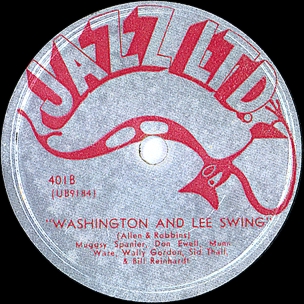
In May 1949, Old Swing-Master concluded a deal to distribute three of the four 78s. (The deal was announced in a Down Beat article on June 17). We don't know how long the distribution deal lasted—in any event, not beyond the collapse of Old Swing-Master in June 1950.
The two Doc Evans sides were left out of the Old Swing-Master deal. George Hoefer's review complained of "fuzzy" sound on them—could this have been a deterrent? (The woolly sonics must have been a pressing fault. Although the masters audibly aren't in perfect condition, the Doc Evans sides actually sound better on CD than some of the others do. An original Jazz Ltd. 301 that we've heard sounds pretty good, too.)
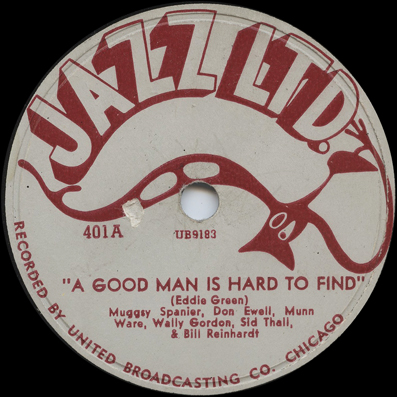
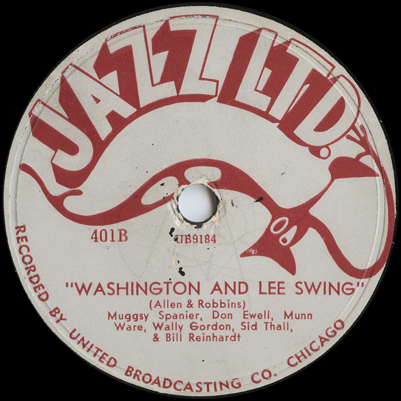
The Jazz Ltd. catalogue, small as it was, retained its commercial viability and saw reissue several times. The first was in the spring of 1951, when New Jersey-based Regal put out a reissue of the original 4-pocket Jazz Ltd. album in the long-play microgroove format. The 8 sides made a standard-length 10-inch LP. Jazz Ltd. went with Regal as soon as Old Swing-Master folded: Billboard, rounding up deals concluded during the NAMM trade show in Chicago (July 11-15, 1950) mentioned that Dave and Jules Braun and Fred Mendelsohn of Regal were in town, and had "bought four masters from Jazz Ltd., diskery owned by Ralph and Ruth Rinehart, local cafe ops" ("NAMM Men Alerted for Biz; Distributors Flock to View New Lines, Labels and Plans," Billboard, July 22, 1950, p. 16). (Billboard was a bit off; the deal was surely to license 8 sides, not to sell 4, and the writer got Bill and Ruth's names wrong.) The Down Beat reviewer noted that the Regal LP's surfaces were "far better" than on the 78 version of the album, and musically complimented Don Ewell's piano on "Maple Leaf Rag" and Muggsy Spanier's drive on "Washington and Lee." The tracks were not put in order by artist or session on the Regal LP masters, which were RL 1319 for Side A and RL 1320 for Side B. The matrix numbers put them around June 1950 in Regal's 1000 matrix series, suggesting that the company had the LP mastered right away.
After licensing to Regal, the Reinhardts still envisioned new releases on Jazz Ltd. In any event, the deal abruptly expired in November 1951, when Regal announced it was shutting down (see our Parkway pages for more on Regal and the company's actitvity buying or leasing sides recorded in Chicago). The Reinhardts appear to have released their own 10-inch LP of the first sessions, sold out of the club. If this materialized, it came out in 1952 and may have borne the number JL1002.
The Jazz Ltd. release was promptly followed by the much more widely distributed Atlantic ALS-140, a 10-inch LP titled Dixieland at Jazz Ltd. Vol. 2.
Atlantic EP 526 was released on 45 rpm sometime in the mid-1950s. On the label and on the sleeve some copies were sold in, it was Dixieland at Jazz Ltd. with Doc Evans. "Jazz Me Blues" from 1951 took up Side B and Evans' two 1949 titles were meant to occupy Side A. "Tipperary" does appear as the first track on Side A, but "Wolverine Blues" was inadvertently replaced with "Maryland, My Maryland" from the Sidney Bechet session (see above). In the past, discographies have failed to mention the 1949 titles—or the switcheroo involving "Maryland, My Maryland"—while putting other 1951 tracks on the EP that weren't there.
The Jazz Ltd. EP, numbered 100 on Side A and 101 on Side B, was a commemorative reissue of Sidney Bechet and Muggsy Spanier sides that came out after Spanier's death 1967; the two Spanier numbers appeared on the A side.
Lord duplicates the listing for the first four Jazz Ltd. items under Jazz Limited (Volume 10, published 1994, p. J256). There only the release on Atlantic LP1261 gets mentioned and the recording date is given as 1959! Lord also leaves off Atlantic ALS-140, but he does mention the companion 10-inch release of the 1951 session on ALS-139.
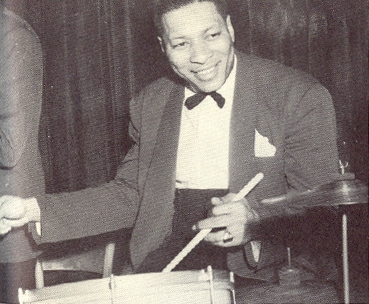
Later in 1951 the Reinhardts brought their house band into the studio to cut 5 extended selections (ranging from a "High Society" that clocked in compactly at 4:17 to a "Tin Roof Blues" that stretched all the way out to 8:06). The aim was to put 4 of them on a 10-inch LP. Doc Evans was back in the fold on this occasion; he had cut his fifth and last 78-rpm album for Joco in April 1950. When he resumed recording in Minneapolis, it was in 1953, for a new small label called Soma.
Doc Evans (tp); Miff Mole (tb); Bill Reinhardt (cl); Ralph Blank (p); Sy Nelson (b); Doc Cenardo (d).
Universal Recording, Chicago, late 1951
| UNIVERSAL 2064 (ALS 11277) (946) |
Jazz Me Blues | Jazz Ltd. U-2064, Atlantic 45-526-B, Atlantic ALS-139, Atlantic LP1261, Delmark DE-226 [CD] | |
| (947) | The Charleston | Jazz Ltd. U-2064, Atlantic ALS-139, Atlantic LP1261, Delmark DE-226 [CD] | |
| UNIVERSAL 2065 (ALS 11278) (948) |
Tin Roof Blues | Jazz Ltd. U-2065, Atlantic ALS-139, Atlantic LP1261, Delmark DE-226 [CD] | |
| (949) | High Society | Jazz Ltd. U-2065, Atlantic ALS-139, Atlantic LP1261, Delmark DE-226 [CD] | |
| Bluin' the Blues | Delmark DE-226 [CD] |
The original Jazz Ltd. LP, using the same label style as the 1949 releases on 78s, was titled A Tribute to Jazz Ltd. and carried the numbers U-2064 on the A side and U-2065 on the B. As on some other early 10-inch LPs (for instance, those released on Rondo) the labels look too small because they are the same size as labels on a 78. No other release number is on the label or the jacket. It was released early in 1952. The original cover art carries the artist's signature and '52 in the lower right corner. From the matrix numbers to the LP sides, in the same series that Universal used for Chance and other small labels, we figure that it was recorded and pressed toward the end of 1951 or the beginning of 1952.
The liner notes for Jazz Ltd. JL1003 (which was released in 1955; see below) would later refer to Doc Cenardo as "the drummer on Jazz Ltd. Vol 1 with Miff Mole, Doc Evans et al." and elsewhere JL1003 would be described as "the third album of records cut by Bill Reinhardt and wife Ruth." Jazz Ltd. U-2064/U-2065 was sold out of the club. Unlike the last Jazz Ltd. LP (11/164; see below), which often shows up on ebay with autographed covers, Jazz Ltd. U-2064/U-2065 appears to be rather rare.
The Atlantic 10-inch LP release came out later in 1952. In fact, the LP side masters for the Atlantic, following the Jazz Ltd. LP, read UNIVERSAL 2064 for Side A and UNIVERSAL 2065 for the B side, except the numbers have been Xed out. Atlantic added its own stamped matrix numbers, A11277 and A11278, to each side, along with an AT.
The Atlantic matrix numbers for individual tracks on this session are as supplied in Tom Lord's Jazz Discography, Vol. 15 (Redwood NY: Cadence Jazz Books, 1996), p. M1001. It is clear from Ruppli's Atlantic Records discography that the matrix numbers in parentheses were attached by Atlantic when it leased the tapes (our thanks to Howard Rye for this information).
Atlantic ALS-139 was a 10-inch LP released in 1952 under the title Dixieland at Jazz Ltd.—Volume 1. It had different cover art from the original Jazz Ltd. release. Since the cover art was the same on Atlantic ALS-139 and 140, there is the possibility that the Atlantic cover art was drawn from the second Jazz Ltd. LP; to be investigated. (The Regal LP used a modified version of the covert art from the original Jazz Ltd. album of 78s.) We are indebted to Neal Umphred's Goldmine Price Guide to Collectible Jazz Albums 1949-1969 (Iola, WI: Krause Publications, 1994), pp. 561 and 572, for release numbers and release dates on the 10-inch LPs. However, Umphred's listing reverses the Atlantic Vol. 1 and Vol. 2.
Atlantic 45-526 was released sometime in the mid-1950s. On the labels (and on the sleeve that some copies were packaged in) it was titled Dixieland at Jazz Ltd. with Doc Evans. "Jazz Me Blues." at just under 6 minutes, took up all of Side B, and Evans' two 1949 titles were meant to occupy Side A (though "Wolverine Blues" was replaced with a Sidney Bechet track; see above). Other titles from this session have been erroneously listed in discographies as appearing on "EP 526" (which obviously couldn't accommodate the entire contents of a 10-inch LP).
Atlantic LP1261, a 12-inch LP released in 1957, was titled Dixieland at Jazz Ltd.
"Bluin' the Blues" never saw issue in any form until the Delmark CD came out in 1994.
The 1948-1949 Jazz Ltd. recordings have been continuously available commercially since their first release. They retained their viability in part because the label's featured artists continued to record and tour and sustain their reputation in the jazz world.
Doc Evans kept his home base in Minnesota after 1949. He continued his career as a respected Dixieland bandleader for the next quarter of a century, recording at least four 78-rpm albums for Joco in 1949 and 1950, then innumerable albums in Minneapolis and on tour, for Soma, Audiophile, H&H, Fat Cat's Jazz, and other labels. He made his last LP in 1975 and died in Minnesota on January 10, 1977.
Don Ewell continued to work, at first largely in Chicago with Eddie Wiggins (1952), Lee Collins (1953), and Kid Ory (1953 - 1955). By the mid-1950s he had moved to San Francisco and begun an association with Jack Teagarden that lasted until the trombonist's death in 1964. Thereafter, he generally worked solo, playing barrelhouse piano. Recording regularly through 1981, he died on August 9, 1983.
Throughout the 1950s Muggsy Spanier continued to work steadily until ill health forced him to retire in 1964. He died in Sausalito, California, on February 12, 1967.
In 1949, Sidney Bechet went to live and work in France, recording extensively over the next few years. He made two tours of the United States in 1951 and 1953. Unfortunately, Bechet appeared to have forgotten that his long-term contract with Jazz Ltd. gave the club an exclusive on his appearances in Chicago. When Bechet showed up at the Blue Note in 1951, Ruth Reinhardt went to court for an injunction. When Bechet returned to Chicago in 1953, he was served with legal papers for breach of contract. Spending the remainder of his career in Europe, Sidney Becht died in Antibes, France on May 14, 1959.
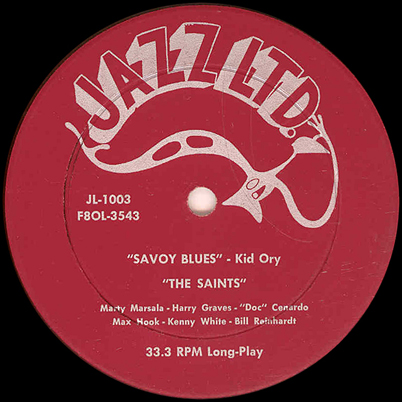
Even though it didn't get Bechet back, the Jazz Ltd. club continued to flourish during the 1950s. In 1955-1956, Jazz Ltd. undertook lengthy recording sessions with two different versions of the house ensemble, using them on two limited-edition LPs.
Marty Marsala (tp); Harry Graves (tb); Bill Reinhardt (cl); Max Hook (p); Kenny White (b); Doc Cenardo (d).
Chicago, before April 1955
| (4386) | Milenburg Joys | Jazz Ltd. JL1003 | |
| (4387) | Bluein' the Blues | Jazz Ltd. JL1003, Atlantic LP1338 | |
| (4388) | Battle Hymn of the Republic | Jazz Ltd. JL1003, Atlantic LP1338 | |
| (4389) | Savoy Blues | Jazz Ltd. JL1003, Atlantic LP1338 | |
| (4390) | The Saints [When the Saints Go Marchin' In] | Jazz Ltd. JL1003, Atlantic LP1338 | |
| (4391) | St. Louis Blues | unissued | |
| (4392) | Portrait in Blue | — | |
| (4393) | I Ain't Gonna Give Nobody None of My Jelly Roll | — | |
| (4394) | Livery Stable Blues | — | |
| (4395) | Train Leavin' on Track No. 10 | — | |
| (4396) | The Mooche | — | |
| (4397) | Blues 'n' Booze | — | |
| (4398) | Washboard Blues | — | |
| (4399) | Riverside Blues | — | |
| (4400) | Tiger Rag | — | |
| (4401) | Someone to Watch over Me | — |
Tom Lord's Jazz Discography, Vol. 10, p. J256, provides session details and matrix numbers but lists only the Atlantic release. February 1960 is the date that the Jazz Ltd. tapes were transferred to and mastered by Atlantic—not the recording date, as Lord would have it. The matrix numbers in the 4000 series were assigned by Atlantic and are not original; we do not know what numbers, if any, the individual tracks originally carried. Lord notes that some of the unissued tracks between matrix 4391 and matrix 4401 could actually be from the next session.
Lord misspells the pianist's name as Max "Nook" for both this and the following session.
The initial release from this session, not listed in any of the standard discographies, was a 10-inch LP, Jazz Ltd. Volume 3: Dixieland by Request (Jazz Ltd. JL1003). The A-side matrix number for the LP was F8OL-3542, while the B side carried F8OL-3543. These are in the RCA Victor series (where F stands for 1955) and indicate that mastering and pressing were done by RCA Victor in Chicago; it is also possible that the session took place at RCA Victor studios but that does not necessarily follow from the matrix numbers (RCA was pressing records for many independent labels during this period). Whether the recording was done at Victor or at Universal Recording, the sound quality of the original Jazz Ltd. LP is excellent.
The date is further narrowed by the proclamation in the notes that the club "is starting its ninth year and will go on and on." Since the club had opened on June 11, 1947, June 1955 is the most likely release date. The Jazz Ltd. release used the short title "The Saints" instead of the full title found on the Atlantic reissue. Our thanks to collector Ken Perkins for alerting us to this rare LP. More recently, Tom Kelly and Robert L. Campbell have turned up copies.
Maybe narrowing the date a little further is an item in Cash Box for April 9, 1955 ("Nesuhi Ertegun Shifts Atlantic LP Line into High Gear," p. 27). The article noted that Atlantic had signed several jazz artists and was rolling 6 LPs out in April. One of these was to be "a special called 'Dixieland By Request At Jazz Ltd.'" Since only some of the planned LPs are described as 12-inch, the implication is that Atlantic had a straight release of the Jazz Ltd. 10-incher in mind. Something interrupted this plan, maybe a decision to release only 12-inch LPs in the future.
Atlantic LP1338, Jazz at Jazz Ltd., was released in 1960. Four titles from the 10-inch LP were put on Side A of this 12-inch LP; "Milenburg Joys" was left off. "The Saints" was shorn of a jokey introduction in which Ruth Reinhardt plays a pushy customer making one more request for "The Saints," and Bill complains that the band has just played it.
No reissues of the Atlantic are known. According to Umphred it was released in mono only, which makes sense given the provenance. The cover illustration was by one-time indie label entrepreneur Phil Featheringill.
Robert L. Campbell's collection now includes two jackets for Atlantic LP 1338, one of which actually had a different Jazz Ltd. LP inside it. These were autographed by much later editions of the Jazz Ltd. band (c. 1965 and c. 1970). Each has an incomplete front cover with only the red separation printed on it (the back liners are complete). The red-only jackets must have been given to the Reinhardts along with copies of the LP to sell at the club.
Three years later, the Reinhardts took another house ensemble into the studio to make another LP, now in the 12-inch format. They would not return to commercial recording until well into the next decade.
Norman Murphy (tp); Dave Remington (tb); Bill Reinhardt (cl); Max Hook (p); Hall Garnes (b); Freddy Kohlman (d).
Chicago, prob. Fall 1958
| J7OW-3322 (4402) |
Panama | Jazz Ltd. JL-1004, Atlantic LP1338 | |
| (4403) | Chimes Blues | Jazz Ltd. JL-1004 | |
| (4404) | Entry of the Gladiators | Jazz Ltd. JL-1004 | |
| (4405) | 'Til [Till] We Meet Again | Jazz Ltd. JL-1004 | |
| (4406) | Farewell Blues | Jazz Ltd. JL-1004, Atlantic LP1338 | |
| (4407) | Slide, Frog, Slide | Jazz Ltd. JL-1004 | |
| J7OW-3323 (4408) |
Bourbon Street Parade | Jazz Ltd. JL-1004 | |
| (4409) | Little Rock Getaway | Jazz Ltd. JL-1004 | |
| (4410) | Yellow Dog Blues | Jazz Ltd. JL-1004 | |
| (4411) | Sensation (Rag) | Jazz Ltd. JL-1004, Atlantic LP1338 | |
| (4412) | Just a Closer Walk with Thee | Jazz Ltd. JL-1004, Atlantic LP1338 | |
| (4413) | I've [sic] Found a New Baby | Jazz Ltd. JL-1004, Atlantic LP1338 |
Our discographical information is drawn from Tom Lord's Jazz Discography, Vol. 10, p. J256. It is possible that some of the unissued tracks with Atlantic-assigned matrix numbers between 4391 and 4401 are actually from this session. Lord incorrectly gives February 1960 as the recording date, but that is when Atlantic leased the tapes from Jazz Ltd. and applied the matrix numbers given in parentheses. Lord incorrectly renders the pianist's name as "Nook."
To further complicate matters, Lord lists JL-1004 again, under Bill Reinhardt's name. He merely gives "1950s" as the date, and puts all of the unreleased sides on the LP. We used to think that the LP was a 10-incher, but a copy recent surfaced for sale on ebay (in April 2012) and it turns out to have been a 12-inch release. So Lord was a bit more accurate than we realized.
We learn from Down Beat (May 30, 1956, p. 29) that Dave Remington had recently joined the Jazz Ltd. house band on trombone (he had been playing piano in the Johnny Lane band at the Red Arrow). Meanwhile, Norman Murphy (identified in the May 30 item as a "St. Louis trumpeter") had joined at some point in the spring of 1956 (the February 8, 1956 issue of Down Beat mentioned Nappy Trottier as the current trumpet player at Jazz Ltd.). In late May 1956, Down Beat noted that Ray Dixon was at the piano and Walt Gifford at the drums. The liner notes to Jazz Unlimited at Jazz Ltd. by the Jazz Inc. Band indicate that Max Hook had been at the club for 3 years and Dave Remington and Norman Murphy for 2. They also indicate that the club had been in business for more than 11 years at the time of release, nailing down 1958 as the year. (The bass player was, of course, added in the studio only.)
The LP carried the same red and silver labels that had previously appeared on Dixieland by Request. The A side showed matrix number J7OW-3322, with J7OW-3323 on the B side. These signify mastering and pressing at some point during 1958 by RCA Victor. Again, we don't know which studio was used for the sessions. The only wording on the spine is "Jazz Ltd. Vol. 4."
Making excellent use of an ensemble that had worked steadily for 2 years with the same personnel, Jazz Unlimited at Jazz Ltd. by the Jazz Inc. Band features a fired-up band with consistently strong soloing from all three horns as well as the piano. Freddy Kohlman, a drummer the Reinhardts had been trying to sign for some time, brought considerable drive to the performances.
Atlantic LP1338, Jazz at Jazz Ltd., was released in 1960. Atlantic had the awkward task of consolidating a 10-inch LP and a 12-inch LP onto one 12-inch release. Consequently, just five tracks out of the 12 on JL-1004 were selected for inclusion, and versions of "Chimes Blues" and "Yellow Dog Blues" running more than 4 minutes had to be excised. There have been no reissues of the Atlantic. According to Umphred, the album was available only in mono, which is what one would expect given the provenance of the material.
In 1960, the Reinhardts moved their club to larger quarters at 162 East Grand. One benefit: they were at last able to employ a regular bass player, and in time they added a guitarist or banjoist as well. While at the new location, they recorded one last LP, identified on the jacket as their fifth. The liner notes refer to the club being in business for 17 years, so it was issued in 1964. (The record company address is given on the back liner as 164 East Grand, which was next door to the club proper, and the postal zone as Chicago 11, Illinois.)
Joe Wiedman (tp); Dave Rasbury (tb); Dave Remington (tb -1, p -2); Bill Reinhardt (cl, voc); Earl Washington (p -1); Reuben "Big Mike" McKendrick (bj -5, g -6, voc); Quinn Wilson (b -3, sousaphone -4); Freddie Kohlman (d).
Universal Recording, Chicago, 1964
| Clarinet Marmalade -1, 4, 5 | Jazz Ltd. 11/164 | ||
| Canal Street Blues -2, 4, 5 | Jazz Ltd. 11/164 | ||
| Bill Bailey [MMcK voc] -1, 3, 6 | Jazz Ltd. 11/164 | ||
| Just a Little While to Stay Here (Reinhardt) -2, 4, 6 | Jazz Ltd. 11/164 | ||
| Georgia on My Mind [BR voc] -1, 3, 6 | Jazz Ltd. 11/164 | ||
| The World Is Waiting for the Sunrise -1, 3, 6 | Jazz Ltd. 11/164 | ||
| Lassus Trombone -1, 4, 5 | Jazz Ltd. 11/164 | ||
| Georgia Camp Meeting -2, 4, 5 | Jazz Ltd. 11/164 | ||
| Tiger Rag -2, 4, 5 | Jazz Ltd. 11/164 | ||
| Shake That Thing [MMcK, ens voc] - 2, 4, 6 | Jazz Ltd. 11/164 | ||
| That's a Plenty -1, 4, 5 | Jazz Ltd. 11/164 |
We were first alerted to this item by Paige van Vorst, who owns a copy. There is a listing for it in Lord—under Bill Reinhardt's name with "1950s" for a date. According to the liner notes, there were two trombones on some tracks (this is most noteworthy on—what else?— "Lassus Trombone," which includes an improvised trombone duet. When Dave Remington, who led the off-night band at Jazz Ltd., played trombone, Earl Washington took over at the piano. (Under Musicians Union rules in Chicago at the time, Union members were allowed to sign contracts only for a 5-day week, hence the importance of the off-night ensemble.) Also, the club's new quarters had a larger stage, with room for a permanent bass player as well as a guitarist, so both Big Mike McKendrick and Quinn Wilson were members of the working ensemble.
The last Jazz Ltd. album includes a few vocals by Big Mike McKendrick and Bill Reinhardt. The World War II era cabaret tax was long gone, so there were no longer any monetary savings in keeping singers out of the club; however, what was by now entrenched Dixieland custom dictated that vocals be entrusted to members of the band.
There is no release number on the jacket, front, back, or spine. The A side label says No. 11 and the B side says No. 164, so where all of that is concerned we have executed a straddle. (On the stereo version, the A side becomes 11S and the B side S164.) On the back of the jacket, members of the band are shown listening to playbacks at Universal Recording.
Copies exist on both standard black and transparent red vinyl. There are both stereo and "Monaurel" copies of the LP in circulation (Richard Rann confirmed the existence of the stereo version and we have now obtained one). Some LPs were apparently sold at the club after the supply of original jackets had been exhausted; a copy in Robert L. Campbell's collection was sold in a defective jacket for Atlantic LP1338 (with just the red separation, instead of the four-color printing normally seen on that front cover).
In the beginning, Jazz Ltd. had gone its own way, staunchly resisting the clichés of most Dixieland operations. But as the 1960s wore on, the club fell into the corny jokes and overly predictable repertoire that alienated fans of other kinds of jazz from the Dixieland circuit. As a consequence the club became more and more dependent on visiting conventioneers as customers.
On the sclerosis that now afflicted Jazz Ltd., Paige Van Vorst (email, July 2, 2004) recalls:
My old friend guitarist-banjoist Emmanuel Sayles worked there for a while (he was called up from New Orleans when Mike McKendrick had his leg amputated ca. 1965) and said it was "the boringest musical job I ever had" as [Bill] Reinhardt insisted they put on the same show every night. Sayles did enjoy meeting the customers and wound up corresponding with several of them long after he moved back to New Orleans to work at Preservation Hall.
An autographed copy of Atlantic LP 1338, offered on ebay in January 2011, carries the signatures of a band from the mid-1960s, including Emmanuel Sayles, on the back liner.
The downward spiral continued as the growth of hotels near O'Hare Airport began to draw convention business away from the area where the club was located.
What was long thought to be the last release on Jazz Ltd. took place in 1967; it was a commemorative 45-rpm EP that drew on the 1948-1949 recordings. The immediate occasion was the passing of Muggsy Spanier. The Reinhardts made it a joint memorial by including Sidney Bechet, who had died in 1959 (though his year of death was misprinted as "1957" on the jacket). The EP consisted of two original Bechet tracks and the two original Spaniers.
And then there was one more. Unlike the last Jazz Ltd. LP, which turns up with some regularity on the used market, this 45-rpm single is scarce. We were unaware of it until a copy was offered on ebay in September 2011. We didn't see photos of the jacket that some copies were sold in until July 2022.
Bill Reinhardt (arr -1, cl, voc, dir); Don Ingle (arr -2, tp); Nap Trottier (tp); Ray Sassetti (tp); Jim Beebe (tb); Bill Corti (tb); Joe Masek (cl, sax); Eddie Higgins (p); Doc Schliesman (bj); Quinn Wilson (sousaphone); Barrett Deems (d); ensemble (voc).
Chicago, 1968
| W4KB-2939 | Illinois (By the Rivers Gently Flowing) (Chamberlain-Stracke-Johnson) -2 | Jazz, Ltd. 821J-2939 | |
| W4KB-2940 | Just a Closer Walk with Thee (trad.) -1 | Jazz, Ltd. 821J-2939 |
Our information was gleaned mostly from the labels of Jazz, Ltd. 821J-2939, which is identified as a "45 E. P." Extended Play normally suggests more than one track per side, which is not the case here: "Illinois" is designated as Side 1 and "Closer Walk" as Side 2. However, "Illinois" runs 4 1/2 minutes and "Closer Walk" clocks in at 5:19. The matrix numbers are from RCA Victor, indicating mastering and pressing by that company, and the W prefix signifies 1968. The "Illinois" side further refers to the number having been copyrighted in 1966 by Otto Kerner, then the governor of the state. What the 821J means, we have no idea, but the 2939 is taken from the Side 1 matrix number.
Some copies of the EP were sold in a jacket that, on one side, gives the sesquicentennial of Illinois statehood as the occasion (Illinois became a state in 1818). On the back, a letter from the governor (who had visited Jazz Ltd.) is reproduced, along with a rationale for the B side ("Just a Closer Walk with Thee" had become the number most often requested at the club). The entire personnel is also listed. The jacket can now be seen at discogs.com.
The sides were recorded in a studio that is not identified on the jacket. The recording was most likely done in stereo but the copy we have located is in mono. Arrangers are credited on both sides and the band was enlarged from the working ensemble. Bill Reinhardt sings on both numbers, which also include some ensemble vocalizing (somewhat unusual on "Just a Closer Walk," an old favorite of his which is, after all, a hymn).
The company address is given as 164 East Grand Avenue, Chicago, Illinois 60611.
Jazz Ltd. finally closed in 1972, the postwar Dixieland explosion now a distant memory. Bill Reinhardt led a Dixieland band at Flaming Sally's in the Blackstone Hotel. His run ended in January 1977. Jim Beebe, who had been Reinhardt's trombonist, kept a couple of other sidemen and formed a new band (Larry Kart, "Sally's Keeps Gleaming with Beebe's High Musical Polish," Chicago Tribune, August 6, 1977, section 6 p. 17). Bill and Ruth moved to San Diego, California, to retire. Ruth Reinhardt died on December 9, 1992. During his last decade of life, Bill Reinhardt developed Alzheimer's and Parkinson's. He died on January 23, 2001.
Around the time of Ruth Reinhardt's death, Bill sold the entire Jazz Ltd. corpus to Bob Koester's Delmark Records. In 1994, Delmark DE-226, Jazz Ltd. Volume 1 assembled on CD all of the 1948-1949 and 1951 tracks, plus excerpts from the 1970 interview with the Reinhardts. Efforts to release a Volume 2 from the 1955 and 1958 sessions have so far been thwarted, because the Reinhardts turned over their tapes to Atlantic while the lease agreement for Atlantic LP 1338 was in force, and the tapes have not been recovered. (One hopes they were not destroyed in the same fire that wiped out big chunks of Atlantic's unreleased material, including tracks by Charles Mingus and Ornette Coleman. But it wouldn't be hard to dub 5 tracks from a clean copy of JL-1003 and 12 from a well preserved JL-1004.) The 1964 and 1968 tapes may be in the possession of Delmark; they have not been reissued.
Sources: Ruth Sato Reinhardt, "Jazz Ltd. Owner Tells Tavern Tale," Down Beat, 21 April 1948, p. 17. John Chilton, Sidney Bechet: The Wizard of Jazz (New York: Oxford University Press, 1987), pp. 202-203. Chilton provides an entire chapter on Bechet's work at Jazz Ltd. and a much more detailed discussion of the Jazz Ltd. operation. Brenda Warner Rotzoll, "Bill Reinhardt; Owned Jazz Ltd., Club on Grand," Chicago Sun-Times, 18 February 2001. We also relied on the extensive reporting by Down Beat on Jazz Ltd. club activities during 1947-1949, and occasional items about Jazz Ltd. during the 1950s. Our thanks to Howard Rye, Ken Perkins, Paige Van Vorst, and Bert Whyatt for their help with this page. Still to be researched are articles by Bert Whyatt in Storyville magazine (June 1993 and 1996-1997) and Don Ingle (Mississippi Rag, November 1977). We expect that at least Ingle's article mentioned the 1968 release.
Click here to return to the Red Saunders Research Foundation page.